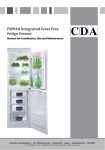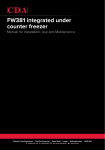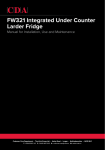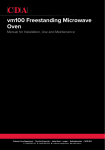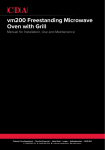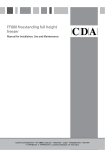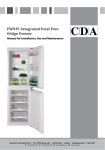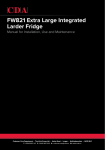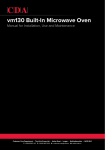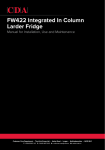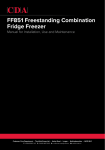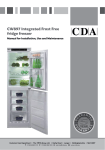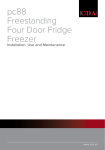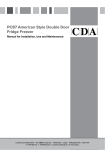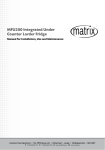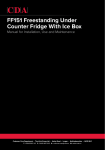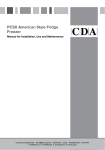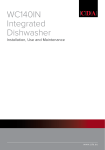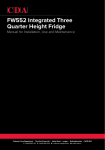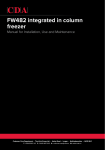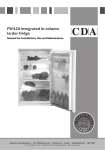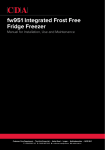Download CDA FW852 fridge-freezer
Transcript
fw852 / fw872 Integrated Fridge Freezer Installation, Use and Maintenance Customer Care Department • The Group Ltd. • Harby Road • Langar • Nottinghamshire • NG13 9HY T : 01949 862 012 F : 01949 862 003 E : [email protected] W : www.cda.eu www.cda.eu Important The manufacturer cannot be held responsible for injuries or losses caused by incorrect use or installation of this product. Please note that we reserve the right to invalidate the guarantee supplied with this product following incorrect installation or misuse of the appliance. This appliance is not designed to be used by people (including children) with reduced physical, sensorial or mental capacity, or who lack experience or knowledge about it, unless they have had supervision or instructions on how to use the appliance by someone who is responsible for their safety. Under no circumstances should any external covers be removed for servicing or maintenance except by suitably qualified personnel. Appliance information: Please enter the details on the appliance rating plate below for reference, to assist CDA Customer Care in the event of a fault with your appliance and to register your appliance for guarantee purposes. Appliance Model Serial Number CE Declarations of Conformity: This appliance has been designed, constructed and marketed in compliance with safety requirements of EEC Directive 2006/95/EEC (Low voltage) and requirements of EMC Directive 2004/108/EEC. 2 This appliance has been manufactured to the strictest standards and complies with all applicable legislation, including Electrical safety (LVD) and Electromagnetic interference compatibility (EMC). Parts intended to come into contact with food conform to EEC/89/109.4 IMPORTANT INFORMATION FOR CORRECT DISPOSAL OF THE PRODUCT IN ACCORDANCE WITH EC DIRECTIVE 2002/96/EC. At the end of its working life, the product must not be disposed of as urban waste. The refrigeration system contains insulating gases and refrigerants, which require specialised waste disposal. The valuable materials contained in this appliance can be recycle. It must be taken to a special local authority differentiated waste collection centre or to a dealer providing this service. Before disposing of an old appliance, remove the door seals, latch or bolt lock to avoid the risk of child entrapment. Disposing of a household appliance separately avoids possible negative consequences for the environment and health deriving from inappropriate disposal and enables the constituent materials to be recovered to obtain significant savings in energy and resources. As a reminder of the need to dispose of household appliances separately, the product is marked with a crossed-out wheeled dustbin. 3 Important Never store inflammable or explosive items and strong corrosive acids or alkalis in the appliance. This is a household appliance, which is produced in accordance with the national standard. It is intended for food storage only, not for storage of blood, medicine and biological products. To prevent risk of fire, keep the appliance away from petrol or any other inflammables. To prevent risk of electromagnetic interference or other accidents, do not place a microwave oven on top of the refrigerator or use any electric appliance inside the refrigerator. Do not allow children to play with or near the appliance. The internal surface of freezer compartment is very cold when the appliance is running. Do not touch the surface especially when hands are wet. Do not splash water onto the appliance. Keep it away from places of high humidity that may have adverse effect on the electric insulation performance. This appliance is designed to be used in ambient temperatures between 10 and 32˚C. Use outside of this range may cause the appliance to fail. 4 Before First Use You must allow the fridge to settle for at least twenty four hours prior to switching the power on. It is recommended that you clean the interior of the appliance prior to first use, using a solution of bicarbonate of soda and warm water and then thoroughly drying the interior. The fridge may have an odour to it at first use. This will disappear as the appliance cools. When first switching the appliance on the fridge will default to 5°C and the freezer to -18°C. The figure in the digital display for freezer temperature will flash until the temperature drops below 0°C. Please note: The appliance will work continuously until it comes down to the correct temperature. If the appliance is switched off, you should allow five minutes before switching it on again to prevent unnecessary damage to the compressor. Never store inflammable or explosive items and strong corrosive acids or alkalis in the appliance. This fridge cools your food by making the inside back of the cavity cold. It is normal for frost to build up on this surface; it then dissipates and drains through a small drain at the bottom, where it evaporates harmlessly. The presence of frosting at the back is not a malfunction of the fridge. 5 Use Fridge • Never put liquids in the refrigerator uncovered. • Never put hot foods in the refrigerator. Warm food should be allowed to cool to room temperature before being put into the refrigerator. • Nothing should rest against the rear wall of the refrigerator, as this will cause frost and possible condensation problems which will be difficult to remove. • Make sure food is clean and any extra water is wiped away before putting into the fridge. • Wrap or cover food before putting into the fridge. This will help prevent the loss of moisture, keep food fresh and avoid unpleasant odours. • Sort foods prior to storing. Any foods to be used soon should be stored at the front of the shelf to prevent deterioration caused by the door being open for prolonged periods. • Do not overfill the fridge. There should be sufficient space between the foods to allow the cool air to circulate. • Thawing frozen foods in the fridge compartment will help to keep the temperature low and save energy. 6 Freezer • The freezer compartments are designed to store only frozen food. • Never put hot or warm foods in the freezer, allow them to cool fully before putting them into the freezer. • Follow the instructions on the food packaging for storage of frozen food. If no information is provided, foods should not be stored for more than three months after the purchase date. • Store food in small packages (ideally less than 2.5kg). This reduces the freezing time and improves the quality of the food after thawing. • Wrap food before putting into the freezer. To stop the wrapping sticking together, ensure it is dry. • Label the food before freezing with information including type of food and dates of storage and expiry. • Once food is thawed, it must not be refrozen unless it has been completely cooked. Only defrost as much food as is required, to prevent wastage. • Bottled or canned drinks should not be stored in the freezer compartments as they could explode. • Check the rating plate to confirm the maximum amount of fresh food that can be frozen within a 24 hour period. • Do not attempt to freeze more than the maximum amount. • To freeze fresh food more quickly, switch on the super freeze function a few hours prior to placing the food in the freezer. • Do not use the super freeze function for more than 24 hours. Use over the recommended time will place unnecessary strain on the refrigeration system. 7 Storage The fridge section is for short term food storage. Although the temperature can be maintained between 0-10˚C, extended periods of food storage is not recommended. As the cold air circulates within the fridge, the temperature can vary between the different sections. As such, foods should be stored in different sections according to type. Section 6 is the coldest part of the fridge. 1 1. Butter 2. Food in jars and bottles 3. Drinks, e.g. milk 4. Cooked food 5. Yogurts and cheese 6.Fresh meat and fish 7. Fruit and vegetables The fridge shelves can be moved according to the storage requirements within the fridge section. To move the shelf, lift up the front section and then pull it outwards. To replace, slide the shelf back into the slot, and the lower the front section. 4 5 2 6 7 3 Fig. 1 Fig. 2 8 Control Panel A B C D E Fig. 3 A. Refrigerator Button This button is used to adjust the fridge temperature between 2°C and 10°C in 1°C increments. To change the temperature setting, press this button once so the display shows the set temperature and flashes. While it is still flashing, press this button several times until the required temperature is shown on the display. Approximately 5 seconds after your last press of this button the new temperature is set and the display changes back to showing the actual temperature inside. After changing the temperature setting the time taken to achieve the new temperature will depend on how big the change is from the previous setting. B. Refrigerator Temperature Display In normal running this shows the actual temperature in the refrigerator compartment. See above for how this is used in setting the refrigerator temperature. 9 C. Freezer Temperature Display In normal running this shows the actual temperature in the freezer compartment. If the temperature in the freezer is higher than 0°C this will flash, otherwise it will be static. See below for how this display is used in setting the freezer temperature. D. Super Freeze Display The super freeze function can be used to freeze large quantities of fresh food as quickly as possible. Fig 3 shows how this display looks when the super freeze is switched on. To switch on the super freeze function, push and hold the freezer button (E) for three seconds. Once the food is frozen, push and hold the freezer button (E) for three seconds again to switch off the super freeze function. IMPORTANT Do not use the super freeze function for more than 24 hours at a time. E. Freezer Button The freezer temperature is regulated by this button between -25°C and -15°C in 1°C increments. To change the temperature setting, press this button once so the display shows the set temperature and flashes. While it is still flashing, press this button several times until the required temperature is shown on the display. Approximately 5 seconds after your last press of this button the new temperature is set and the display changes back to showing the actual temperature inside: it will continue to flash if the actual temperature in the freezer is above 0°C, and until the actual temperature falls below zero. 10 After changing the temperature setting, the time taken to achieve the new temperature will depend on how big the change is from the previous setting. Switching On and Off When the fridge freezer is connected to a power supply it will automatically switch on. It may be switched off without disconnecting the power supply by pressing and holding the refrigerator button (A) and the freezer button (E) at the same time for approx. five seconds. Pressing these two buttons together again for a further five seconds will switch the fridge freezer back on. Note that when doing this there may be a delay before the motor starts, this is not a fault with the appliance. 11 Care and Cleaning Drain Plug Always disconnect the appliance from the power supply before any cleaning or maintenance. The fridge and freezer sections should be cleaned using a solution of bicarbonate of soda and lukewarm water. Do not use abrasive products or detergents. After washing, rinse and dry thoroughly. Clean the shelves and balconies separately by hand with a mild solution of washing up liquid and water. Do not put them in the dishwasher. Water Outlet fig. 4 The water drain hole at the back of the fridge compartment and the evaporating tray should be cleaned periodically to prevent the defrosted water from collecting inside the fridge compartment. The drain plug can be used to clean the drain hole. If the appliance is not to be used for prolonged periods of time, unplug and clean the appliance. The doors should be left slightly ajar to prevent the formation of mildew and unpleasant odours. 12 Defrosting the Fridge The fridge is self-defrosting. Any water created will run out of the fridge through the channel at the back of the fridge. It is important to keep the channel clear at all times using the cleaning tool supplied. The defrosted water is collected in the evaporating tray at the back of the appliance and dissipated by evaporation. Defrosting the Freezer Do not use heaters or defrosting sprays in this appliance. Never use any metallic or sharp objects such as knives or forks to remove the ice as this could damage the lining. The freezer compartment should be defrosted regularly to ensure the most efficient running of the freezer. Once the ice is more than 5mm thick, the freezer should be defrosted. •24 hours before defrosting the freezer, turn the super freeze function on to ensure the frozen food is fully frozen. •Before switching off the freezer, wrap the the frozen food in sheets of paper and store it in a cool place. • Remove the freezer drawers. •To speed up the process, place a bowl of warm water in the base of 13 the freezer compartment. •The freezer should be cleaned using a solution of bicarbonate of soda and lukewarm water. Do not use abrasive products or detergents. After washing, rinse and dry thoroughly. •Clean the drawers separately by hand with a mild solution of washing up liquid and water. Do not put them in the dishwasher. • Once cleaning is complete, reconnect the power. 14 Troubleshooting If you have any problems with your appliance, you should check the troubleshooting prior to calling CDA Customer Care to prevent unnecessary service calls and potential cost. If the appliance is not working • Check there is power to the appliance. • The house fuses are intact and the fuse in the plug has not blown. • The on/off switch is not set to off. • The plug socket is functioning fine. To check this, plug another electrical appliance in to see if the socket is faulty. The appliance is working, but not very well • The appliance is not overloaded. • The thermostat is set to an appropriate temperature. • The doors are closing properly. • The cooling system at the rear of the appliance is clean and free of dust, and not touching the rear wall. • There is enough ventilation at the side and rear walls. The appliance is noisy • The appliance is level and stable. • The side and rear walls are clear, and there is nothing resting on the appliance. • Note: The cooling gas in the refrigerator may make a slight bubbling or gurgling noise, even when the compressor is not running. 15 There is water in the lower part of the refrigerator compartment • The drain hole in the channel at the back of the compartment is clear. Ice has formed on the back wall of the fridge • It is normal for some ice droplets to form on the back wall of the fridge. This does not constitute a fault with the appliance. • Ensure that no items inside the fridge are in contact with the back wall. 16 Installation and Ventilation fw852 This appliance must never be installed close to heat sources, e.g. heating elements, cookers or in damp places. • To ensure the appliance is level, you should use the height adjustable feet at the front of the appliance. • The cooling system at the rear of the appliance must not touch the rear wall. • The appliance must be installed with adequate ventilation. Ensure that there is clearance above the appliance to allow air to escape and that there is space between the rear of the appliance and the wall. Fig. 5 fw872 Fig. 6 The diagram shows the ventilation requirements for your appliance. Failure to provide adequate ventilation can lead to increased running costs and premature failure and may invalidate the warranty provided with the appliance. 17 Ventilation The main consideration when installing any refrigeration unit into a fitted kitchen is ventilation. The heat removed from the cooling compartment needs to be dissipated into the atmosphere. Incorrect ventilation can lead to premature compressor failure, excessive power consumption and total system failure. For products intended to be installed into a tall housing unit, the following requirements need to be met: Important Please follow the instructions to install this unit. An air intake should be provided somewhere in the cabinet run to allow free air in. In this example, a plinth vent is shown underneath the refrigerator . The top of the cabinet needs to be vented into the room Refrigerator outline Recommended size of vent opening: 500 x 35mm If the furniture does not allow free air into the room then a plinth vent, or other means of ventilation needs to be provided to ensure a natural flow of air A thin section of the plinth can be removed to allow air into the unit (recommended 600mm x 10mm) Min 30mm There should be space at the rear of the cabinet to allow cool air to be drawn over the condenser. Recommended: 500 x 35mm 300 300 plan view of cut out and ventilation gaps Fig. 7 18 A hole should be cut in the supporting shelf, as shown below The open channel at the rear is clearly shown. For the correct operation of the appliance it is important that the top of the housing unit is not blocked off. A channel depth of 40-50mm is normal with most units. A hole is shown in the base shelf of the unit; this allows air to be drawn over the compressor & heat exchange. Some installers fit a decorative plinth vent. In most cases this is not required, but is a welcome aesthetic addition. As a rule, the more air can get in, the better and more efficient the operation of the product. 19 Mounting the Fascia Doors • Position the appliance within the unit. Ensure that there is a gap of 3 to 4mm between the non-hinged side and the cabinet wall. • Locate the slider in the bracket and fix the slider to the fascia door 20 to 22mm from the edge of the fascia as shown in figure 8, ensuring that the slider is positioned centrally and horizontally within the bracket. Tighten securely by hand. • Fill the gap on the non-hinged side with the seal strip provided, as shown in figure 9. x4 20 mm Fig. 8 door gasket 20 Fig. 9 Reversing the Doors We recommend you seek the help of another individual to support the doors whilst performing this operation. 1.Carefully prise off the cover cap for the top hinge and unscrew the screws fixing the top hinge to the appliance, you should support the upper door whilst doing this. 2.Carefully remove the upper door and place it somewhere safe. Note that there are spacers between the door and the hinge; note how many and their position. 3.Remove the central hinge by removing the 3 screws fixing it to the appliance; support the lower door whilst doing this. 4.Remove the lower door and place it somewhere safe, again noting the position of any spacer pieces. 5.Swap the previous top hinge to the opposite side at the bottom. 6.Refit the lower door using any spacers and position the central hinge on the door. After removing the 3 cover caps, fix the hinge securely to the appliance. 7.Swap the previous bottom hinge to the opposite side at the top. Refit the upper door and the “new” top hinge and fix securely to the appliance. 8.Fit the central cover caps and top hinge cover pieces in place to complete the process. 9. Unscrew all four slider brackets from the doors and swap them over to the side furthest from the new hinge positions, before the decor door is fitted. 21 Ensuring the door seals correctly: It is normal for the seal to be compressed after the door has been reversed. With the door closed, use a hair dryer to expand the seal and fill the gap between the door and the body of the appliance. Take care not to use the hair dryer too close to the appliance, which could damage the seal. A distance of approximately 10 cm should be adequate. When completed, allow the seal and door to cool before touching them. Once done, the seal will remain in position. Electrical Information Warning! This appliance must be earthed. Green and Yellow to Earth A 13 Amp Brown to Liv e B 13 Amp fuse Cord Clamp Fig. 10 Blue to Neutra l The mains lead of this appliance has been fitted with a BS 1363A 13Amp fused plug. To change a fuse in this type of plug, follow the steps below: 1. Remove the fuse cover and fuse. 2. Fit replacement 13A fuse, ASTA approved to BS 1362 type, into the fuse cover. 22 3. Replace fuse cover. Important: Do not use the appliance without the fuse cover in position. How to connect an alternative plug If the fitted plug is not suitable for your socket outlet, then it should be cut off and disposed of safely to avoid possible shock hazard. A suitable alternative plug of at least 13 Amp rating to BS 1363 should be used. As the colours of the wires in the mains lead of this appliance may not correspond with the coloured markings identifying the terminals in your plug, proceed as follows:• The wire which is coloured GREEN and YELLOW must be connected to the terminal which is marked with letter (E) or by the Earth symbol or coloured GREEN and YELLOW. • The wire which is coloured BLUE must be connected to the terminal which is marked with the letter (N) or coloured BLACK. • The wire which is coloured BROWN must be connected to the terminal which is marked with the letter (L) or coloured RED. If in doubt regarding the electrical connection of this appliance, consult a qualified electrician. Do not shorten the supply cable, the appliance may require removing for servicing. N.B. Ensure that the plug socket is situated in an easily accessible place after installation. E & O E. All instructions, dimensions and illustrations are provided for guidance only. CDA reserve the right to change specifications without prior notice. 23 Please contact our Customer Care Department for Service on the details below E parts YEAR labour lC DA applia Customer Care Department • The Group Ltd. • Harby Road • Langar • Nottinghamshire • NG13 9HY T : 01949 862 012 F : 01949 862 003 E : [email protected] W : www.cda.eu copyright © CDA 2014 s al ce on Customer Care Department The Group Ltd. • Harby Road • Langar • Nottinghamshire • NG13 9HY T : 01949 862 012 F : 01949 862 003 E : [email protected] A R A N TE GU YEAR n www.cda.eu
























